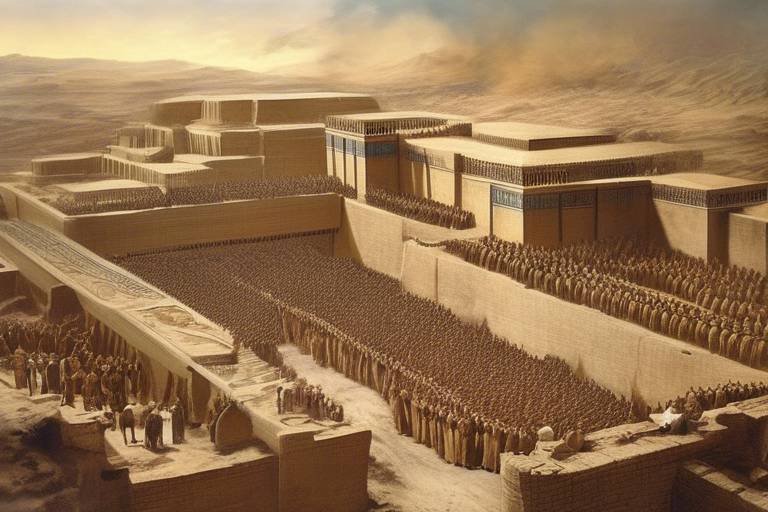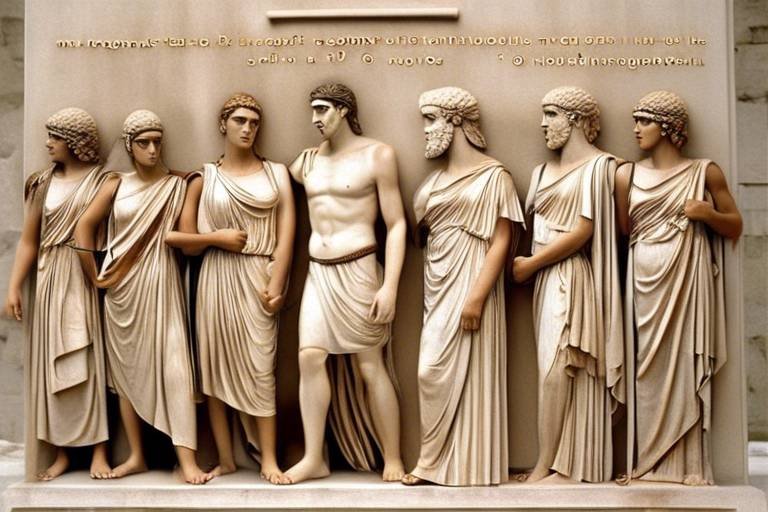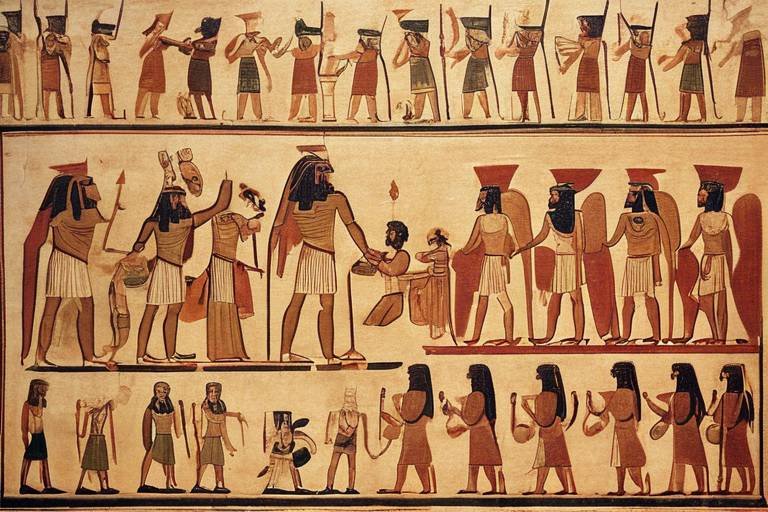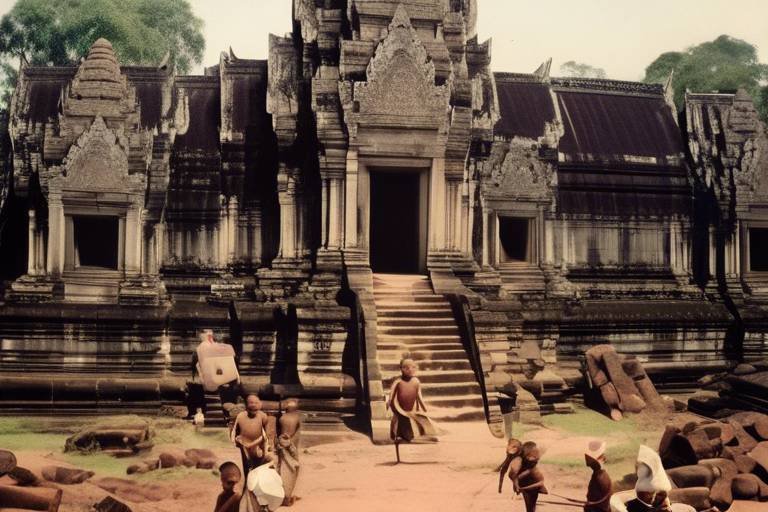The Secrets of the Lost Civilizations of Central America
Central America holds mysteries of ancient civilizations waiting to be uncovered. From the Mayans to the Aztecs, delve into the enigmatic past of these cultures and the secrets they left behind for modern explorers to discover.

The Rise of the Mayans
The rise of the Mayans is a fascinating journey into the ancient past of Central America. This civilization, known for its remarkable advancements in various fields, including astronomy, mathematics, and architecture, captivates historians and archaeologists alike. The Mayans' intricate calendar system, which some believe to be more accurate than our modern calendar, showcases their deep understanding of celestial movements and timekeeping.
Imagine standing before the towering pyramids and intricate temples built by the Mayans, marveling at the precision and skill that went into constructing these monumental structures. Each stone carefully placed, each carving telling a story of a civilization that thrived in harmony with nature and the cosmos.
As we delve deeper into the secrets of the Mayans, we uncover not just their architectural marvels but also their complex social structure and religious beliefs. The Mayans' reverence for the natural world and their gods is evident in every aspect of their society, from their elaborate rituals to their intricate artwork.
One cannot help but wonder how a civilization as advanced and sophisticated as the Mayans could eventually decline and fade into obscurity. The mysteries surrounding the collapse of their cities and the reasons behind their downfall continue to intrigue researchers and historians to this day.

The Enigmatic Aztec Empire
When it comes to ancient civilizations, the Aztec Empire stands out as one of the most enigmatic and powerful societies in Central America. Nestled in the heart of Mesoamerica, the Aztecs built their capital city of Tenochtitlan on an island in Lake Texcoco. This strategic location not only provided natural defenses but also showcased the engineering prowess of the Aztec people. With intricate canals, causeways, and floating gardens, the city of Tenochtitlan was a marvel of urban planning and ingenuity.
One of the defining features of the Aztec Empire was its complex social structure. At the pinnacle of society was the ruler, known as the Huey Tlatoani, who held both political and religious power. Beneath the ruler were nobles, priests, warriors, and commoners, each playing a vital role in the functioning of Aztec society. The Aztecs were known for their elaborate religious practices, including human sacrifices to appease their gods and ensure the prosperity of their empire.
Despite their military prowess and sophisticated society, the Aztec Empire faced a mysterious and sudden collapse. Spanish conquistadors, led by Hernan Cortes, arrived in the early 16th century and swiftly conquered the Aztec capital. The fall of Tenochtitlan marked the end of the Aztec Empire, leaving behind a legacy shrouded in mystery and intrigue. The reasons for the decline of this once-mighty civilization continue to puzzle historians and archaeologists to this day.

The Olmec Legacy
The Olmec civilization, often revered as the mother culture of Mesoamerica, holds a significant place in the history of Central America. Their legacy is shrouded in mystery, with monumental stone heads scattered across the region, each bearing enigmatic expressions that whisper tales of a bygone era. These colossal sculptures stand as silent sentinels, guarding the secrets of a civilization that laid the foundation for future cultures to flourish.
One of the most intriguing aspects of the Olmec legacy is their sophisticated society, characterized by intricate social structures and advanced artistic expression. The Olmecs were master craftsmen, creating intricate jade figurines and elaborate pottery that showcased their artistic prowess. Their influence extended far beyond their borders, shaping the artistic traditions of subsequent civilizations in Central America.
At the heart of the Olmec civilization lies La Venta, a monumental ceremonial site that served as a spiritual center for the ancient culture. Here, massive earthen mounds and intricate stone carvings stand as a testament to the Olmec's religious beliefs and ceremonial practices. The site's layout and architecture offer a glimpse into the spiritual world of the Olmec people, shedding light on their rituals and beliefs.
One of the enduring mysteries of the Olmec civilization is the purpose and significance of their colossal stone heads. Carved with remarkable precision and attention to detail, these massive sculptures have puzzled archaeologists for centuries. Some believe that they represent revered leaders or deities, while others speculate about their role in religious ceremonies or as symbols of power and authority.
As modern explorers continue to uncover the secrets of the Olmec legacy, new discoveries shed light on the enigmatic civilization that laid the groundwork for the great empires of Central America. Through ongoing archaeological excavations and research, the mysteries of the Olmec civilization are gradually being unraveled, offering a glimpse into the rich tapestry of ancient cultures that once thrived in the heart of Mesoamerica.

mother culture
The Olmec civilization, often referred to as the of Mesoamerica, holds a significant place in the history of Central America. This ancient civilization, flourishing between 1400 and 400 BCE, laid the foundation for many aspects of subsequent cultures in the region. The Olmecs are renowned for their colossal stone heads, believed to represent rulers or deities, showcasing their artistic and sculptural skills. These enigmatic artifacts continue to puzzle archaeologists and historians, offering glimpses into the rich cultural tapestry of the Olmec society.

of Mesoamerica. Investigate their colossal stone heads, complex society, and the influence they had on subsequent Central American cultures.
Central America holds mysteries of ancient civilizations waiting to be uncovered. From the Mayans to the Aztecs, delve into the enigmatic past of these cultures and the secrets they left behind for modern explorers to discover.
Explore the origins and development of the Mayan civilization, known for its advanced knowledge in astronomy, mathematics, and architecture. Uncover the secrets behind their monumental structures and intricate calendar system.
Discover the powerful Aztec civilization, with its capital city of Tenochtitlan and elaborate social structure. Learn about their religious practices, military prowess, and the mysterious disappearance of their civilization.
Unravel the mysteries of the Olmec civilization, often considered the mother culture of Mesoamerica. Investigate their colossal stone heads, complex society, and the influence they had on subsequent Central American cultures.
Journey to the ancient city of El Mirador, one of the largest Mayan sites ever discovered. Explore its massive pyramids, intricate stelae, and the secrets hidden within its dense jungle surroundings.
Delve into the archaeological site of Copan, known for its impressive hieroglyphic stairway and intricate sculptures. Uncover the history of this Mayan city and the mysteries surrounding its decline.
Investigate the enigmatic city of Teotihuacan, home to the iconic Pyramid of the Sun and Moon. Explore the religious significance of this ancient metropolis and the secrets of its construction and sudden abandonment.
Discover the ancient city of Tikal, a prominent Mayan center known for its towering pyramids and well-preserved temples. Learn about its significance in Mayan history and the ongoing efforts to preserve this archaeological treasure.
Join modern archaeologists and researchers as they continue to unravel the mysteries of Central America's lost civilizations. Follow their expeditions, discoveries, and the ongoing efforts to preserve and protect these ancient sites for future generations.
The Olmec civilization, often referred to as the mother culture of Mesoamerica, holds a significant place in the history of Central America. By exploring their colossal stone heads, intricate society, and the profound influence they had on subsequent cultures in the region, we can gain valuable insights into the development of Central American civilizations.
Q: What was the significance of the Mayan calendar system?
A: The Mayan calendar system was highly advanced and used for various purposes such as tracking time, agricultural cycles, and religious ceremonies.
Q: Why did the Aztec civilization suddenly disappear?
A: The exact reasons for the decline of the Aztec civilization are still debated among historians, but factors such as Spanish conquest, internal conflicts, and diseases brought by the Europeans are believed to have played a role.
Q: How are modern researchers preserving the ancient sites of Central America?
A: Modern researchers employ various conservation and restoration techniques to protect the ancient sites, including monitoring visitor numbers, implementing structural support, and using non-invasive methods for exploration.

The Lost City of El Mirador
The Lost City of El Mirador takes us on a captivating journey back in time to one of the most significant Mayan sites ever unearthed. Nestled deep within the dense jungles of Guatemala, El Mirador stands as a testament to the ingenuity and architectural prowess of the ancient Mayan civilization. The site boasts massive pyramids that pierce the sky, intricate stelae adorned with intricate carvings, and sprawling complexes that hint at a once-thriving metropolis.
Walking through the ancient ruins of El Mirador, one can't help but feel a sense of awe and wonder at the sheer scale of the structures that have withstood the test of time. The towering pyramids, some reaching heights comparable to modern skyscrapers, speak volumes about the advanced engineering skills possessed by the Mayans. Each step taken in El Mirador is a step back in time, unraveling the mysteries and secrets buried within its crumbling walls.
One of the most intriguing aspects of El Mirador is the intricate network of causeways that connect various parts of the city, allowing for efficient movement and communication among its inhabitants. These causeways, adorned with intricate carvings and symbols, offer a glimpse into the daily life and societal structure of the ancient Mayans who once called El Mirador home.
As archaeologists continue to excavate and study El Mirador, new discoveries are constantly being made, shedding light on the rituals, beliefs, and practices of the ancient Mayan civilization. The site serves as a treasure trove of information for researchers seeking to unravel the enigmatic past of Central America's lost civilizations.

The Legacy of Copan
The Legacy of Copan takes us deep into the heart of the Mayan civilization, where the archaeological site of Copan stands as a testament to the ingenuity and artistry of this ancient culture. Nestled in the lush landscapes of present-day Honduras, Copan was once a thriving city known for its intricate sculptures, impressive architecture, and advanced hieroglyphic writing system. The site is adorned with the famous Hieroglyphic Stairway, a masterpiece of Mayan artistry that tells the stories of Copan's rulers and history.
As you wander through the ruins of Copan, you can't help but marvel at the intricate carvings and detailed inscriptions that adorn the structures. The site's Great Plaza is a sight to behold, with its majestic temples and ball courts that once echoed with the sounds of ancient ceremonies and rituals. The legacy of Copan extends beyond its physical structures, offering a glimpse into the daily lives, beliefs, and customs of the Mayan people who called this city home.
One of the most intriguing aspects of Copan is the mystery surrounding its decline. While the exact reasons for the city's abandonment remain a subject of debate among archaeologists, the site continues to reveal new insights into the complexities of Mayan society and the factors that may have led to the downfall of this once-great civilization.
Exploring the legacy of Copan is like unraveling a captivating story written in stone, where each carving, temple, and plaza holds a piece of the puzzle waiting to be discovered. As modern explorers delve deeper into the secrets of this ancient city, the legacy of Copan continues to inspire awe and fascination, offering a window into the rich history of the Mayan civilization.

The Mysteries of Teotihuacan
Teotihuacan, the ancient city shrouded in mystery and intrigue, continues to captivate explorers and historians alike. Situated in present-day Mexico, this enigmatic metropolis boasts the iconic Pyramid of the Sun and Moon, towering structures that whisper tales of a bygone era. The very essence of Teotihuacan's existence raises questions that echo through time, beckoning us to unravel its secrets.
One of the most puzzling aspects of Teotihuacan is its sudden abandonment. Why did this once-thriving city, teeming with life and energy, fall into silence and obscurity? Theories abound, from internal unrest to external invasions, yet the truth remains elusive, hidden within the ancient stones of this remarkable site.
The religious significance of Teotihuacan adds another layer of complexity to its mysteries. The intricate layout of the city, aligned with celestial bodies and adorned with symbolic artwork, suggests a deep connection to spiritual beliefs and practices. But what rituals took place within its sacred precincts, and what gods did its inhabitants worship?
Archaeologists and researchers continue to uncover clues that shed light on the enigmas of Teotihuacan. Recent excavations have revealed intricate murals, elaborate tombs, and evidence of a sophisticated urban society. Each discovery brings us closer to understanding the daily lives, customs, and beliefs of the ancient Teotihuacanos.
As we gaze upon the majestic structures of Teotihuacan, we are reminded of the fleeting nature of civilizations, the rise and fall of empires, and the enduring legacy of those who came before us. The mysteries of this ancient city serve as a testament to human ingenuity, creativity, and the eternal quest for knowledge and meaning.

The Legacy of Tikal
Located in the heart of the Guatemalan jungle, Tikal stands as a testament to the grandeur and sophistication of the ancient Mayan civilization. The legacy of Tikal is deeply rooted in its towering pyramids, intricate temples, and expansive plazas that once bustled with life and activity. As one of the most significant Mayan centers, Tikal played a crucial role in the political, economic, and cultural landscape of Mesoamerica.
At the core of Tikal's legacy lies its architectural achievements, exemplified by the majestic Temple of the Great Jaguar and the towering Temple of the Masks. These monumental structures not only showcase the Mayan's engineering prowess but also serve as a window into their religious beliefs and societal hierarchy. The intricate carvings and glyphs adorning the temples offer valuable insights into the spiritual and ceremonial practices of the ancient Mayans.
Moreover, Tikal's strategic location amidst the dense jungle highlights the Mayan's deep connection with nature and the cosmos. The city's layout, aligned with celestial events such as solstices and equinoxes, reflects the Mayan's advanced knowledge of astronomy and their reverence for the natural world. The towering pyramids served as both ceremonial centers and astronomical observatories, allowing the Mayans to track celestial movements with remarkable precision.
Despite the grandeur of Tikal's architectural marvels, the city's decline and eventual abandonment remain shrouded in mystery. The reasons behind the collapse of this once-thriving metropolis continue to puzzle archaeologists and historians, sparking debates and theories about the factors that led to Tikal's demise. From environmental challenges to political upheaval, the legacy of Tikal raises intriguing questions about the resilience and vulnerability of ancient civilizations.
Today, Tikal stands as a UNESCO World Heritage Site, attracting visitors from around the globe who seek to explore its rich history and immerse themselves in the mystical ambiance of the Mayan ruins. The ongoing efforts to preserve and protect Tikal ensure that future generations can continue to marvel at the legacy of this ancient city and appreciate the ingenuity and creativity of the Mayan people.

Uncovering the Truth
Uncovering the Truth about the lost civilizations of Central America is an ongoing journey filled with excitement and surprises. Modern archaeologists and researchers are tirelessly working to unveil the secrets hidden beneath the ancient ruins scattered across the region. Through meticulous excavations, groundbreaking discoveries, and cutting-edge technology, they are piecing together the puzzle of these enigmatic cultures.
These dedicated individuals delve deep into the jungles, climb towering pyramids, and decipher intricate hieroglyphics to shed light on the mysteries that have baffled historians for centuries. Their passion for unraveling the past drives them to explore remote sites, uncover hidden chambers, and analyze artifacts that offer glimpses into the lives of ancient civilizations.
As each new revelation comes to light, the stories of the Mayans, Aztecs, Olmecs, and other lost civilizations are brought back to life. The intricate connections between these cultures, their technological advancements, and their spiritual beliefs are slowly being unveiled, painting a vivid picture of a rich and complex history.
Through collaborative efforts and international partnerships, researchers are able to share their findings with the world, sparking interest and curiosity in the hearts of both scholars and the general public. The preservation of these archaeological sites is paramount, ensuring that future generations can continue to explore and learn from the wonders of Central America's ancient past.
Frequently Asked Questions
- What are some of the key features of the Mayan civilization?
The Mayan civilization was known for its advanced knowledge in astronomy, mathematics, and architecture. They built impressive structures such as pyramids and temples, had a complex calendar system, and developed a sophisticated writing system known as hieroglyphics.
- What led to the mysterious disappearance of the Aztec civilization?
The exact reasons for the decline of the Aztec civilization remain a topic of debate among historians and archaeologists. Factors such as Spanish conquest, internal conflicts, and the spread of diseases brought by the Europeans are believed to have contributed to the downfall of the Aztec empire.
- What is the significance of the Olmec civilization in Mesoamerica?
The Olmec civilization is often referred to as the "mother culture" of Mesoamerica due to its influence on later civilizations in the region. They were known for their colossal stone heads, advanced artistry, and complex societal structure, laying the foundation for future Central American cultures.
- Why is El Mirador considered one of the most important Mayan sites?
El Mirador is renowned for its massive pyramids, intricate stelae, and dense jungle surroundings, making it a significant archaeological site. It provides valuable insights into the urban planning, architecture, and cultural practices of the ancient Mayan civilization.
- What ongoing efforts are being made to preserve the archaeological sites in Central America?
Modern archaeologists and researchers are actively working to preserve and protect the ancient sites of Central America. Conservation projects, excavation techniques, and community engagement initiatives are being implemented to safeguard these valuable remnants of the past for future generations.



















